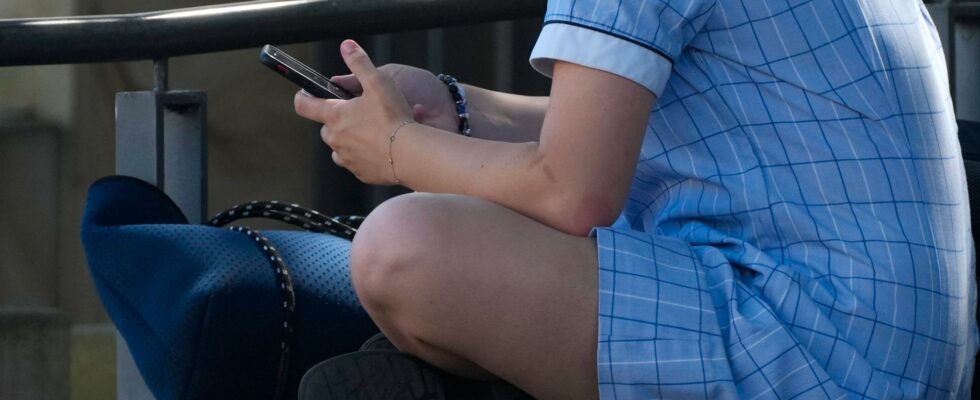unsaveSave
An Australian schoolgirl with her cell phone in Sydney, New South Wales. Archive image.
1 / 4Photo: Rick Rycroft/AP/TT
Australia has put its foot down against popular platforms such as Facebook, Instagram and X.
Social media is banned for children under 16 – now the tech giants have to find ways to stop young people from using them.
– As soon as the children started using social media, the addiction was huge, says Swedish teenage parent Josefin Fox in Australia – who at the same time sees bans as the wrong way to go.
Half past twelve at night and after a heated debate, last week the Australian Senate clubbed a ban on social media for children under 16 years of age.
“A platform for peer pressure, a source of anxiety, a tool for fraudsters and, worst of all, a tool for online criminals,” Prime Minister Anthony Albanese said ahead of the vote, urging young people to put down their phones and head to the sports fields.
He represents the centre-left Labor Party and is one of those who have pushed for a change in the law.
When the law goes into effect, social media companies must take “reasonable steps” to prevent young teenagers from having accounts. The companies risk fines of up to 50 million Australian dollars (about 355 million Swedish kronor) if they do not comply with the rules.
Intense debate
Although the law was passed with a good majority in parliament, the debate has been intense and many have expressed concerns.
– The concept of excluding part of our population from a form of communication does not feel good. I respect the arguments of my colleagues who think we should do something, and clearly we should do something, but not like this, for example, Liberal Senator Richard Colbeck said before the vote, ABC reports.
On paper, the new law is one of the strictest in the world. At the same time, there are basically no clear details on how the ban will be enforced in practice. It will be up to the social media giants behind the platforms to find technical solutions.
Everything must be in place within a year.
– An infrastructure is required, otherwise it can be a blow to the air if you just set up a requirement without knowing how it should be followed, says Daniel Westman, a lawyer specializing in media law.
He also sees challenges linked to a requirement for identification.
– If there is a requirement to be identified in order to use these services, it will have consequences for other users as well. Then you can’t have anonymous accounts, for example, and that can be good or bad, he says.
“The change is total”
Swedish Josefin Fox lives since 2012 in Wollongong near Sydney with her children, who are 13 and 16 years old.
– I have thought a lot about this and what actually lies behind the proposal. It will be so fast to hammer through the new law and I wonder why they don’t make sure to discuss it properly first, she tells TT.
At the same time, she agrees that children and young people’s use of social media is a huge problem.
– As soon as the children started using social media, the addiction was huge and they want to sit with their mobile phones all day. The change is total and many of us parents experience that, she says.
– If you ask me if it would be better for children not to be on social media, the answer is yes. But if you ask me if a ban is the right way to go, I doubt it. How do you check that it is complied with? I think it is difficult to achieve in practice, says Josefin Fox.
“Will find a way”
Many young people are also expected to try to circumvent the rules.
– I want to continue using it. It will feel weird not having it and being able to talk to all my friends back home. I will find a way. And so will all my other friends, says 12-year-old Angus Lydom to AFP.
Alexandra Weilenmann is a professor of interaction design at the University of Gothenburg. In addition to the practical difficulties associated with a ban and its compliance, she also sees other problems.
– In my opinion, it’s not about whether we should have social media or not. It’s much more complicated than that, but it doesn’t work politically. You handle it with the hard gloves and then the ban applies, she says.
Weilenmann emphasizes that social media is good and bad, and that a ban hits even the positive.
– But it is of course much more complicated and costly to direct efforts towards what is problematic. It is quite easy for a politician to say that something is banned, she says.
FACTSWhich services are affected by the law?
No specific list of platforms covered by the 16 age limit law that has been pushed through in Australia has been published.
The law’s definition of social media is very broad. It describes social media as an electronic service that meets the following conditions:
– The sole or primary purpose of the Service is to enable online social interaction between two or more end users
– The Service allows End Users to link or interact with any or all other End Users
– The service allows end users to post material on the service.
Source: ABC
Read more
